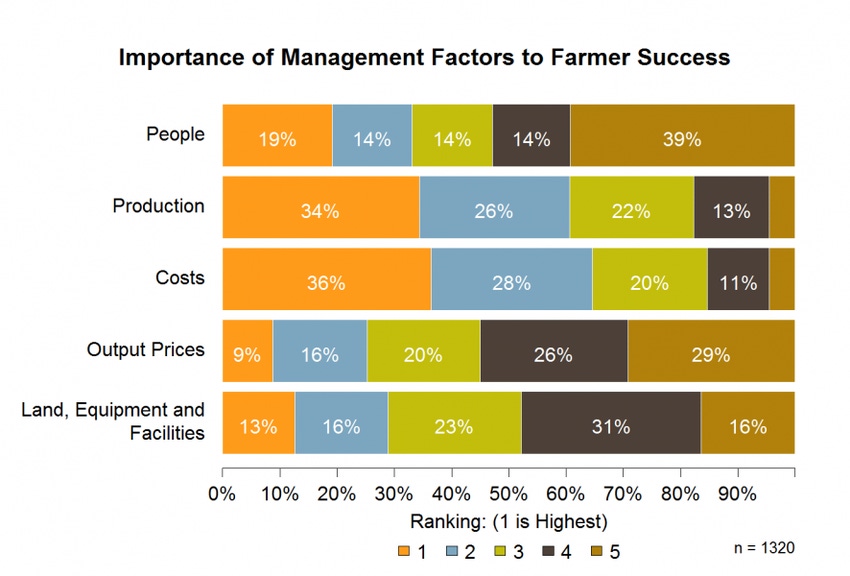August 30, 2017

By Allan Gray, Purdue University
Understanding our customers’ businesses provides us opportunities to identify offerings or solutions to help them accomplish their goals. Part of understanding their business involves understanding the elements they believe lead to their success. At the Center for Food and Agricultural Business, we explored farmers’ perceptions of their most critical success factors in our latest Large Commercial Producer survey. Our goal was to determine if there were differences in farmers’ perceptions of the factors that drive their success. The graph below summarizes the results from the more than 1300 farmers across the U.S. who answered the question.
The question asked producers to rank five factors in terms of importance to the success of their farming operation. The five factors were: people management, production management, cost management, marketing management, and asset management. The graph above indicates the proportion of farmers who ranked each of the factors 1st, 2nd, 3rd, etc. From my perspective, there are a number of insights from this preliminary set of results. Some of those insights include:
1. The largest portion of producers identified managing cost as the No. 1 factor in their success, followed relatively closely by managing production. A deeper analysis indicates that a large portion of producers ranked those two factors as 1st and 2nd in one order or the other. I believe this is an indication of how producers focus much of their decision-making on managing their economic productivity. From a crop perspective, I would think about this as managing their cost per bushel. They understand that their business depends heavily on their ability to be as efficient as possible. This means managing costs while not giving up their yields. Dr. Mike Gunderson and I have written in the past about the importance of having conversations with our producers about product cost per bushel, rather than just the price of the product. It would seem that producers are telling us they are ready and willing to have the discussion.
2. Marketing is not key factor of most producers’ success. This would seem to be a counter-intuitive result as most of us would be conditioned to believe marketing skills are critically important for the farmer. I am not sure that the results suggest it is not important to have marketing skills for your farm. Instead, I believe this result is a clear indication that producers have not designed their farms to be successful based on the “hope” that they would receive consistently high prices. Most importantly, I think this result suggests that producers believe their success is based on things they can control and not things they can’t control. We would do well to understand this viewpoint as we have discussion and develop relationships with our key producer clients.
3. A final, interesting insight, comes from examining the answers to these questions based on the age of producers. The results suggest that a larger proportion of the younger generation (18-35-year-olds) see people management as a critical part of their farms’ success. There could be a number of reasons for this. For example, a slightly larger proportion of the younger respondents in the survey come from larger farms. But this by itself doesn’t fully explain this group’s focus on people. We believe it is likely that this younger generation is part of multigenerational businesses where they have responsibility for managing people to accomplish production activities. In fact, a number of other questions in this broad survey also indicate the younger generation’s focus on people both on and off the farm business and the keen interest they seem to have in developing human relations.
Obviously, the insights from this question, and all of the other interesting questions explored in the 2017 Large Commercial Producer Survey, deserves further exploration. We will continue to explore the results in detail over the coming months and will bring you many more insights at the National Conference for Food and Agribusiness in November.
You May Also Like




